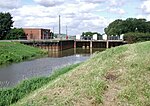Marfleet railway station
Beeching closures in EnglandDisused railway stations in Kingston upon HullFormer North Eastern Railway (UK) stationsHull and Holderness RailwayPages with no open date in Infobox station ... and 4 more
Railway stations in Great Britain closed in 1964Railway stations in Great Britain opened in 1854Use British English from January 2018Yorkshire and the Humber railway station stubs

Marfleet railway station is a disused railway station on the North Eastern Railway's Hull and Holderness Railway in the Marfleet area of the city of Hull in the East Riding of Yorkshire, England. It was opened by the Hull and Holderness Railway on 27 June 1854. The station was closed to passengers on 19 October 1964 and to freight on 1 May 1972.
Excerpt from the Wikipedia article Marfleet railway station (License: CC BY-SA 3.0, Authors, Images).Marfleet railway station
Marfleet Lane, Hull Marfleet
Geographical coordinates (GPS) Address External links Nearby Places Show on map
Geographical coordinates (GPS)
| Latitude | Longitude |
|---|---|
| N 53.753 ° | E -0.272 ° |
Address
Marfleet
Marfleet Lane
HU9 5RN Hull, Marfleet
England, United Kingdom
Open on Google Maps









